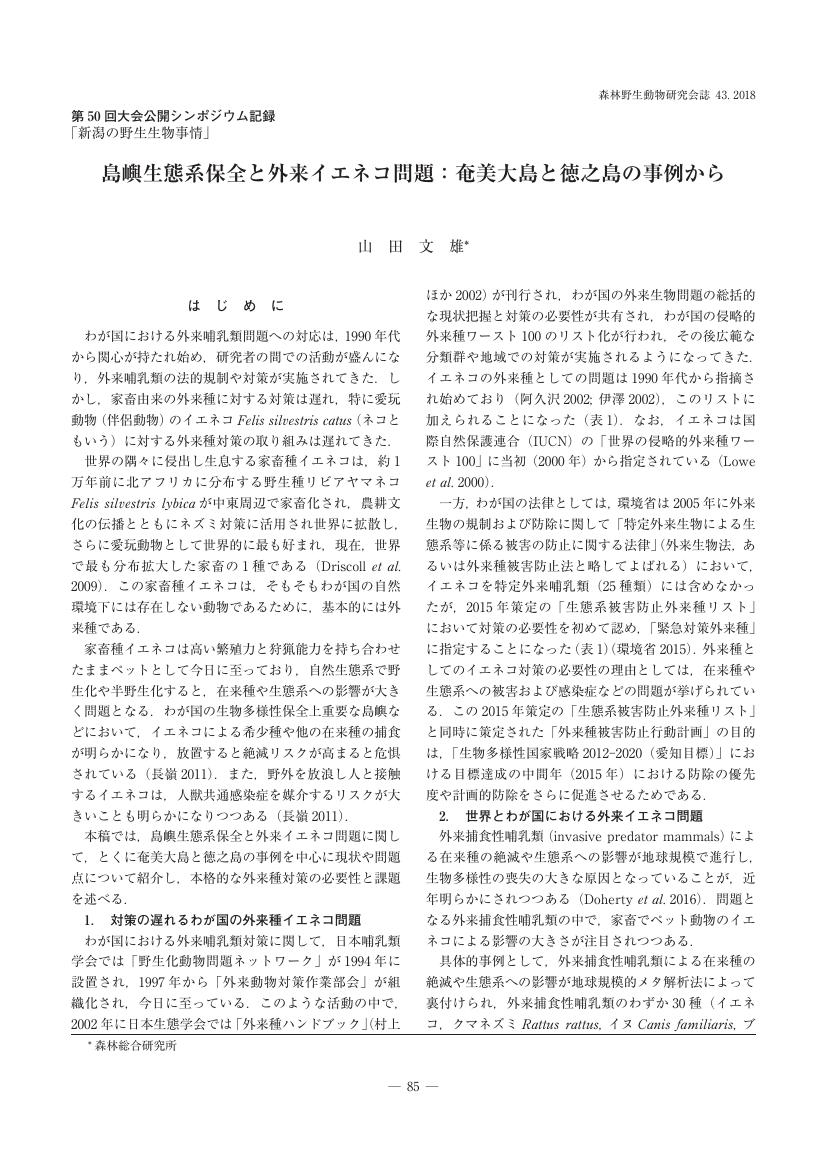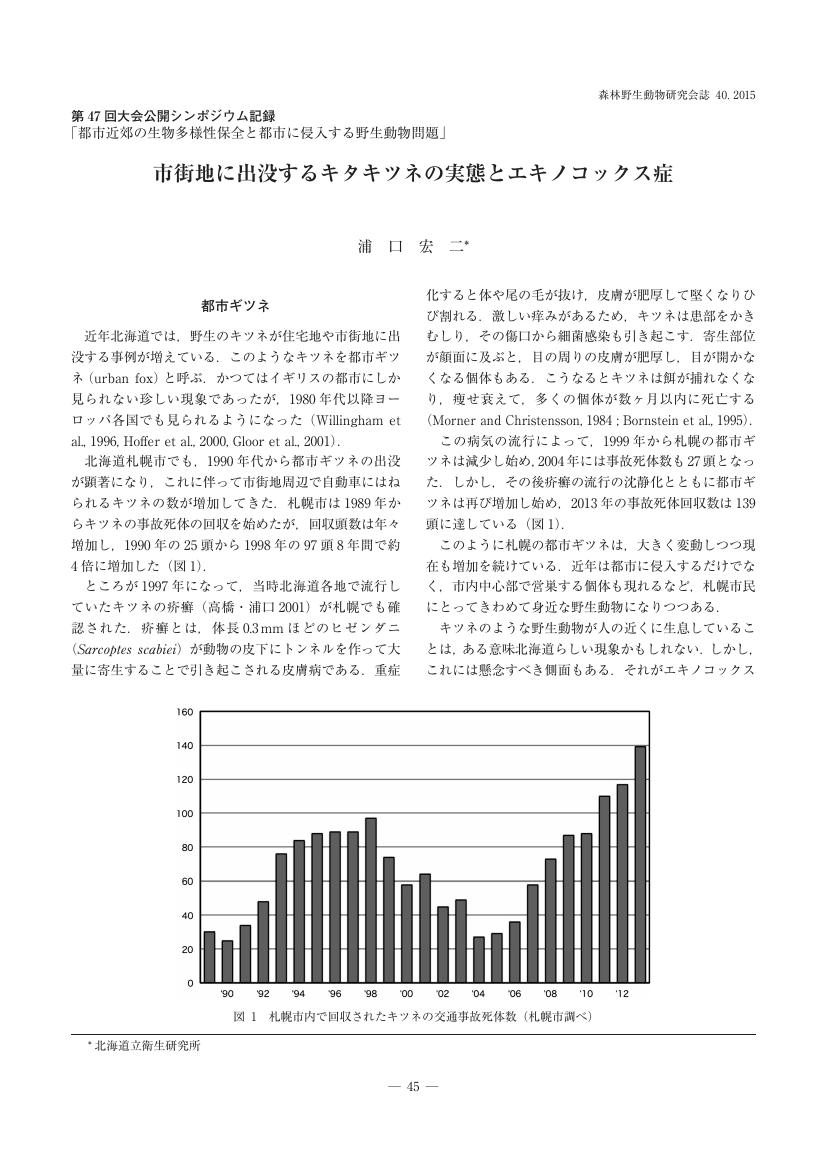- 著者
- 石井 信夫
- 出版者
- 森林野生動物研究会
- 雑誌
- 森林野生動物研究会誌 (ISSN:09168265)
- 巻号頁・発行日
- vol.42, pp.59-62, 2017-03-30 (Released:2020-04-01)
- 参考文献数
- 6
- 被引用文献数
- 1
8 0 0 0 OA エゾシカの高密度化に対するマルハナバチ群集の応答
- 著者
- 赤羽 俊亮 日野 貴文 吉田 剛司
- 出版者
- 森林野生動物研究会
- 雑誌
- 森林野生動物研究会誌 (ISSN:09168265)
- 巻号頁・発行日
- vol.41, pp.1-9, 2016-03-30 (Released:2019-09-21)
- 参考文献数
- 41
エゾシカが高密度に生息する洞爺湖中島と生息密度の低い洞爺湖湖畔地域で,エゾシカの高密度化がマルハナバチ類に及ぼす影響について考察するため,マルハナバチ類の個体数,種数および種構成を両地域で比較した.中島と湖畔の各3ヶ所でマルハナバチ類の捕獲および林床の開花植物の調査を実施した.中島よりも湖畔で採集個体数は有意に多かったが,種数には違いが見られなかった.nMDSを用いて群集構成を比較したところ,両調査地域間に差異があった.両地域の優占種であるエゾオオマルハナバチの個体数は中島の方が少なく,さらに他種の個体数は中島では非常に少なかった.また中島では林床植物の開花フェノロジーに中断が見られた.これらの結果から,エゾシカの高密度化がもたらす植生改変が,開花フェノロジーの断絶を介してマルハナバチの個体数を減少させ,種構成を変化させる可能性が示唆された.
4 0 0 0 OA 九州に定着した特定外来生物クリハラリスの由来と防除
- 著者
- 安田 雅俊
- 出版者
- 森林野生動物研究会
- 雑誌
- 森林野生動物研究会誌 (ISSN:09168265)
- 巻号頁・発行日
- vol.42, pp.49-54, 2017-03-30 (Released:2020-04-01)
- 参考文献数
- 31
4 0 0 0 OA 北海道陸別町におけるヒグマの農作物被害
- 著者
- 藤巻 裕蔵
- 出版者
- 森林野生動物研究会
- 雑誌
- 森林野生動物研究会誌 (ISSN:09168265)
- 巻号頁・発行日
- no.20, pp.5-7, 1994-05
Damage by Brown Bear Ursus arctos to agriculture products in Rikubetsu-cho, eastern Hokkaido, was 69 times for 13 years from 1979 to 1991 based on agriculture damage records of Rikubetsu-cho. Agriculture products damaged were corns, sugar beets, nest boxes of honey bee and cattle. Of them corns and sugar beets were damaged frequently in September and October. Brown bears gave damages nearby the boundary between cultivated field and forest. Sizes of cultivated fields damaged ranged from 0.01 to 1.2 ha with averages of 0.09-0.32 ha for corns and 0.03-0.06 ha for sugar beets. In Rikubetsu-cho 13 bears were killed for 12 years from 1980 to 1992 (10 animals by sport hunting and 3 animals by control hunting).
3 0 0 0 OA 広島市で捕殺されたツキノワグマ
- 著者
- 江草 真治 福本 幸夫
- 出版者
- 森林野生動物研究会
- 雑誌
- 森林野生動物研究会誌 (ISSN:09168265)
- 巻号頁・発行日
- vol.21, pp.17-22, 1995 (Released:2017-10-03)
1.1994年7月12日未明に広島市の市街地にツキノワグマの成獣(メス)1頭が現れ、市民2名を負傷させ、射殺処分された。2.病理解剖の結果、胃内容物の種類と量、マダニ類の寄生状態等により本個体は野生個体であると考えられた。3.本個体が市街地に出現した理由は不明であるが、この時期はツキノワグマにとって交尾期にあたり、雄の執拗な追尾から逃れるために市街地に出現したとも考えられる。4.出現地に最も近いクマの生息地は北西に直線距離で約3.5km離れた広島市安佐南区山本町であり、ここから太田川沿いに移動した可能性が最も高い。5.市民に対する加害原因は、犬飼らの分類による[排除]と区分した。
3 0 0 0 OA 御蔵島の世界最大のオオミズナギドリ繁殖集団を激減させたノネコの影響
- 著者
- 岡 奈理子
- 出版者
- 森林野生動物研究会
- 雑誌
- 森林野生動物研究会誌 (ISSN:09168265)
- 巻号頁・発行日
- vol.44, pp.65-72, 2019-03-31 (Released:2023-05-02)
- 参考文献数
- 21
3 0 0 0 OA 島嶼生態系保全と外来イエネコ問題:奄美大島と徳之島の事例から
- 著者
- 山田 文雄
- 出版者
- 森林野生動物研究会
- 雑誌
- 森林野生動物研究会誌 (ISSN:09168265)
- 巻号頁・発行日
- vol.43, pp.85-92, 2018-03-30 (Released:2021-04-01)
- 参考文献数
- 22
- 被引用文献数
- 1
3 0 0 0 OA 野生ヒグマによる人身事故の防止対策
- 著者
- 門崎 允昭 河原 淳
- 出版者
- 森林野生動物研究会
- 雑誌
- 森林野生動物研究会誌 (ISSN:09168265)
- 巻号頁・発行日
- vol.18, pp.50-66, 1991 (Released:2017-10-03)
The authors investigated 43 accidents resulting in injury or death due to attack by wild brown bears Ursus arctos, occurring in Hokkaido Japan in the 22 years from 1970 through 1991. Characteristics of bear attacks on humans and countermeasures to prevent injury are presented. Causes for attacking humans: Causes of bear attacks on humans can be divided into three main areas. (1) Attacks with an intention to eat humans: These occur when bears develop a longing to hunt, kill and eat prey, especially after a long time on a vegetable diet. (2) Attacks to drive away humans: These occur in the following cases. When bears desire to eat foods which human bring, farm products or livestock under human's care, or in protecting their territory or food. Attacks on hunters, i.e. bear's counterattack against hunter's attack on bears. This occurs (i) When hunters miss bears from close range. (ii) When a hunter chases a wounded bear, bears very often attack suddenly from a hidden vantage point. (iii) When a hunter shoots a baby bear before the dam, she will angrily attack the hunter. When humans encounter bears suddenly, bears attack humans without warning. In particular, a mother bear will attack humans for approaching. (3) Attacks for sport or excitement: Some young bears, especially those around two years old attack humans for sport or excitement. In some incidents the causes overlap, or in the middle of an attack the cause may shift to another motive. Type of bears involved in attacks: Bears attacking hunters are characterized as being over two years old and either sex, whereas attacks on people other than hunters are in most cases perpetrated by dams accompained by young, or bears of ages two to four years regardless of sex. Body part attacked: Bear attacks on hunters are usually directed at the head, then on the legs, body and neck in order of frequency. People other than hunters are usually attacked on the legs, head and neck, and body. Manner of attack: In late hibernation and directly after, bears attack humans largely using the teeth on all fours. At times other than the hibernation period, bears usually attack people by standing erect and using the claws. Bears with a history of attacking people will use the same method as used in previous attacks. Man-eating bears: Sometimes, bears will eat a man at the scene of the killing. In most cases after killing a man, the bear will drag the body to a safe place and strip the man naked or cover the dead body with soil, fallen leaves or chopped long herbs. Parts eaten: Portions of the human body which bears eat are largely muscles and protruding part such as nose, ears and penis. They rarely eat internal organs. Preventing injury: To obviate bear attacks on humans, hunters should avoid firing or pursuite which will lead to sudden counter-attack. Ordinary people should carry a sound-making instrument, such as a whistle or a bell, and a hatchet for self-protection when entering an area presumed to be a bears' habitat. While walking, people should blow or rattle the sound-making instrument, or raise their voices in order to avoid encountering bears unexpectedly. If people should encounter a bear and the bear approach them obstinately, people should not be overawed by the bear. They should chant a spell to admonish the bear for his evil intention of attacking a man, and to encourage themselves as the Ainus, the aborigines of Hokkaido, used to do. Another method is to shout at the bear with a loud voice. Such actions often cause the bear to leave. If a person runs to escape, bears are sure to attack them. Therefore, people should never run to escape, even if bears assume a threatening attitude. If a bear should deliver an actural attack on a person, they should respond with a blow of their hatchet on any part of the bears' body. This will make the bear flinch, and sometimes, give a chance of survival. Feigning death:(View PDF for the rest of the abstract.)
3 0 0 0 OA 市販の小型GPSロガーを用いた外来ハリネズミの行動圏調査法の検討
- 著者
- 三谷 奈保 山田 千紘 小松 孝明
- 出版者
- 森林野生動物研究会
- 雑誌
- 森林野生動物研究会誌 (ISSN:09168265)
- 巻号頁・発行日
- vol.40, pp.7-13, 2015-03-30 (Released:2018-04-01)
- 参考文献数
- 21
市販の小型GPSロガー(GT-120)の精度と有用性について検証した.ハリネズミ4頭にGT-120および特定小電力無線を利用した発信器を装着し,そのうち3頭をラジオ・トラッキングにより再捕獲した.1分間隔でおよそ2日分以上の測位地点が得られた.また,巣の位置や休息時間を特定することが可能であった.GT-120を用いて,ラジオ・トラッキングに比較して著しく多い測位地点を省力的に得ることができた.ただし,留意すべきこととして,測位誤差が平均33.2±41.9m(SE)であった.
- 著者
- 山田 文雄
- 出版者
- 森林野生動物研究会
- 雑誌
- 森林野生動物研究会誌 = Journal of the Japanese Wildlife Research Society (ISSN:09168265)
- 巻号頁・発行日
- no.43, pp.85-92, 2018-03
3 0 0 0 OA 洞窟棲コウモリ類による発泡スチロール製バットボックスの利用
- 著者
- 谷崎 美由記 市川 伸彦 木村 明彦 柳川 久
- 出版者
- 森林野生動物研究会
- 雑誌
- 森林野生動物研究会誌 (ISSN:09168265)
- 巻号頁・発行日
- no.37, pp.27-30, 2012-03-29
An experiment was carried out to see whether bat boxes made of foamed styrol would be used by cave-dwelling bats. The boxes were installed in a tunnel currently used as roosting spots. Two years later, 30 to 40 Myotis sp. individuals were observed to have colonized the boxes.
3 0 0 0 OA 田村典子[著], 2011, リスの生態学, 東京大学出版会, 211pp.
- 著者
- 山根 明臣
- 出版者
- 森林野生動物研究会
- 雑誌
- 森林野生動物研究会誌 (ISSN:09168265)
- 巻号頁・発行日
- no.37, pp.45-47, 2012-03-29
2 0 0 0 OA ニホンジカの分布拡大と生態系へのインパクトについて
- 著者
- 梶 光一
- 出版者
- 森林野生動物研究会
- 雑誌
- 森林野生動物研究会誌 (ISSN:09168265)
- 巻号頁・発行日
- vol.39, pp.29-31, 2014-03-28 (Released:2017-04-26)
- 参考文献数
- 2
- 被引用文献数
- 1
2 0 0 0 OA 神奈川県アライグマ防除実施計画における防除の取り組みと現状
- 著者
- 永井 広野
- 出版者
- 森林野生動物研究会
- 雑誌
- 森林野生動物研究会誌 (ISSN:09168265)
- 巻号頁・発行日
- vol.45, pp.35-41, 2020-03-31 (Released:2023-05-19)
- 参考文献数
- 7
- 著者
- 塩野﨑 和美 山田 文雄 柴田 昌三
- 出版者
- 森林野生動物研究会
- 雑誌
- 森林野生動物研究会誌 (ISSN:09168265)
- 巻号頁・発行日
- vol.43, pp.1-11, 2018-03-30 (Released:2021-04-01)
- 参考文献数
- 28
- 被引用文献数
- 1
野外にいるイエネコによる在来希少種の被害が深刻化している奄美大島では,イエネコ管理のために適正な飼養を求める条例が2011年に全5市町村で施行された.ネコ飼育者と非飼育者のネコ問題に対する意識の違いを把握することは,条例の効果的な運用上重要であるため,奄美市に住む無作為に選ばれた20歳以上の男女1,000人と動物病院を訪れるネコ飼育者を対象としたアンケートによる意識調査を2013~14年に行った.全有効回答者378人中,飼育者の割合は14.6%(55人)であった.条例の認知率は飼育者,非飼育者とも約70%と高く,義務化された飼いネコへの首輪等の装着を守る飼育者の割合も約75%と高い結果を示した.しかし,ネコ問題の存在,飼い猫条例の必要性,ネコの適正飼養の必要性に対する意識は飼育者のほうが非飼育者よりも明らかに低かった.このことから,奄美市の飼い猫条例の効果を高めるには普及啓発による飼育者の理解促進と意識改革が最も重要と考えられる.
- 著者
- 持田 誠 谷村 愛子 吉沼 利晃
- 出版者
- 森林野生動物研究会
- 雑誌
- 森林野生動物研究会誌 (ISSN:09168265)
- 巻号頁・発行日
- vol.29, pp.3-7, 2003
The digestive tract of a Japanese Green Pigeon Sphenurus sieboldii collected on the Hariusu coast of western Hokkaido was found to contain various plant species. Among them the Vitaceae were most remarkable. Prunus sp. was also present, but most Prunus seed were damaged, whereas Vitis sp. seeds retained their original form in the crop.
2 0 0 0 OA 市街地に出没するキタキツネの実態とエキノコックス症
- 著者
- 浦口 宏二
- 出版者
- 森林野生動物研究会
- 雑誌
- 森林野生動物研究会誌 (ISSN:09168265)
- 巻号頁・発行日
- vol.40, pp.45-49, 2015-03-30 (Released:2018-04-01)
- 参考文献数
- 9
2 0 0 0 OA 2001年度に北海道で発生したヒグマによる人身事件4件
- 著者
- 門崎 允昭
- 出版者
- 森林野生動物研究会
- 雑誌
- 森林野生動物研究会誌 (ISSN:09168265)
- 巻号頁・発行日
- vol.28, pp.19-25, 2002 (Released:2017-10-03)
The first and third incidents occurred while the victims were collecting edible wild plants. The other incidents occurred when the victims were hunting bear. In the first incident, a 42 year old woman was killed instantly by the bear that was protecting its young. In the third incident, the lone eight year old male bear dragged the 53 year old man about ninety meters to a comfortable spot where the bear then proceeded to eat the victim's muscle tissue. These facts suggest that in the third case, the purpose of the bear attack was to eat the man. In the second and fourth incidents, the bear retaliated against being shot by the hunter. In the second incident a 70 year old man was left in a critical condition. In the fourth incident, an 81 year old man was killed instantly. The causes of bear attacks against people can be divided into three general categorys; to eat people, to repel people and to play with people. Three of the incidents are in the category of repelling people, the other incident is in the category of attacking to eat.
2 0 0 0 OA 北海道産ヒグマに寄生するマダニ類の年間動態
- 著者
- 小澤 良之 門崎 允昭
- 出版者
- 森林野生動物研究会
- 雑誌
- 森林野生動物研究会誌 (ISSN:09168265)
- 巻号頁・発行日
- vol.22, pp.29-42, 1996 (Released:2017-10-03)
A survey of the seasonal movement of the population of five species of ticks lxodidae collected from both wild brown bears Ursus arctos and their habitat yeilded the following results The smallest population of ticks except winter in both areas (on both the bears and in their habitat) was found to be in August due to dormancy under high temperatures. This was in common with all the five species. Ixodes ovatus population composed of only adults in both areas changed synchronously. Haemaphysalis megaspinosa population in both areas showed a lag of one month, because of the low prevalence of nymphs on the bears. However, there was found on abundent occurrence of nymphs and larvae in the bears habitat. The other three species (H. japonica, H. flava, I. persulcatus) in both areas changed irregularly because of the differences of developmental stages of ticks which compose each population and because of the prevalence of them to bears, respectiverly.
2 0 0 0 OA 多雪地域低山帯の越冬鳥類群集
- 著者
- 金子 与止男
- 出版者
- 森林野生動物研究会
- 雑誌
- 森林野生動物研究会誌 (ISSN:09168265)
- 巻号頁・発行日
- vol.37, pp.7-15, 2012-03-29 (Released:2017-10-03)
冬季に多量の降雪のある新潟県の低山帯で越冬鳥類の個体数調査を実施した.得られたデータを用い,食性・採食場所にもとつくニッチ占有タイプ,群れで生活するか単独で生活するかといった社会構造との関連を分析した.3冬季間に47種の鳥類が観察された.1977/78年の冬季は出現鳥類の個体数が少なかったが,1978/79年と1979/80年は個体数が多かった.個体数の多かった種は,シジュウカラ,カシラダカ,エナガ,アトリ,ホオジロ,スズメ,マヒワであった.積雪の多い1月と2月には,ホオジロのように地面で採食する鳥は調査地からいなくなった.多雪地の低山帯で冬季に見られる鳥類で個体数の多い優占種はシジュウカラやエナガなどの混群形成種であり,アトリやマヒワなど放浪性のあるアトリ科の鳥が多数飛来するときには前者を上回り優占種になると考えられた.








